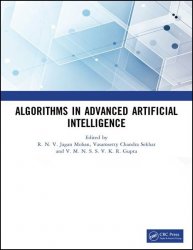Algorithms in Advanced Artificial Intelligence
- Добавил: literator
- Дата: 12-06-2024, 21:46
- Комментариев: 0
 Название: Algorithms in Advanced Artificial Intelligence
Название: Algorithms in Advanced Artificial IntelligenceАвтор: R.N.V. Jagan Mohan, Vasamsetty Chandra Sekhar
Издательство: CRC Press
Год: 2024
Страниц: 547
Язык: английский
Формат: pdf (true)
Размер: 60.7 MB
Algorithms in Advanced Artificial Intelligence is a collection of papers on emerging issues, challenges, and new methods in Artificial Intelligence, Machine Learning, Deep Learning, Cloud Computing, Federated Learning, Internet of Things, and Blockchain technology. The book addresses the growing attention to advanced technologies due to their ability to provide “paranormal solutions” to problems associated with classical Artificial Intelligence frameworks. AI is used in various subfields, including learning, perception, and financial decisions. It uses four strategies: Thinking Humanly, Thinking Rationally, Acting Humanly, and Acting Rationally. The authors address various issues in ICT, including Artificial Intelligence, Machine Learning, Deep Learning, Data Science, Big Data Analytics, Vision, Internet of Things, Security and Privacy aspects in AI, and Blockchain and Digital Twin Integrated Applications in AI.
The modern era has seen a significant increase in data, making it increasingly challenging for humans to comprehend and process information. That information might have a lot of valuable and potential values that are hidden. Clustering is recognized as an essential element in data mining, particularly for the analysis of enormous amounts of data. There are several clustering techniques in the data mining literature, but among the many algorithms, The k-means approach and its adjusted varieties have gotten a parcel of intrigued within the field of expansive information examination. These days, neural network-based clustering, K-means variety, fluffy C-means, and probabilistic C-means clustering, collaborative sifting clustering, and its developments are all well-known approaches for clustering endless sums of information. This survey study’s main objective is to offer a venue for discussing the various clustering techniques applied to effective large-data clustering. This review examines over a dozen research publications on effective big data clustering methods, showcasing results using WEKA and KNIME data mining programs. The paper critically reviews previous studies and explores the advantages of K-Means clustering over Big Data analytics in various research areas. This paper provides a comprehensive overview of the shortcomings and issues of several large information clustering strategies, aiming to assist students in their journey towards improved big data clustering.
Technological advancements in the field of psychological assessment enable machines to accurately determine user emotions through the Recognition of Emotions in Speech method. Recognition of Emotions in Speech accurately predicts human emotions through speech, improving psychological assessment. Recognition of Emotions in Speech can identify emotions like impartial, at ease, joyful, depressed, scared, furious, disgusted, and shocked. The paper presents a Federated Learning (FL) method for emotion recognition in speech based on the Mel Frequency Cepstral Coefficient (MFCC). The study employs the RAVDESS dataset and the Federated Learning System for Cognitive Radio to develop speech-emotion identification classifiers. In the source-filter model of speech, the vocal tract is represented by MFCC, which are important speech features that are extracted for recognition tasks. When attempting to extract spectral information from expressive speech, the Fourier transform signal processed via a Mel-spaced reduce bank is the most widely used method. The Federated Learning Architecture is used in an experimental speech-emotion recognition scenario to accurately extract spectral information from expressive speech using the RAVDESS dataset and the Federated Learning System for Cognitive Radio.
False information that is reported as news and frequently intended to harm reputations or make money is called fake news. It has been used to refer to all types of misleading information since it was first introduced in the 1890s and is frequently produced by adversarial foreign actors. Due to the variety of fake news kinds, experts increasingly prefer the term “information disorder” as a neutral and educational word. The study addresses information overload and filtering issues on social media by introducing a new approach to assessing news reliability. It uses Cosine Similarity based Retriever Augmented Generation (RAG) technique and classification Deep Learning algorithm to classify news as fake or real, with the best-performing feature predicting its authenticity. The system achieved 91% accuracy in testing. The Machine Learning component of Artificial Intelligence is crucial increasing systems for learning and performing tasks. Various algorithms, including supervised, unsupervised, and Reinforcement learning is used in various industries. This project proposes using Naive Bayes, Logistic Regression, Random Forest, SVM, and KNN to identify fake news.
Скачать Algorithms in Advanced Artificial Intelligence
Внимание
Уважаемый посетитель, Вы зашли на сайт как незарегистрированный пользователь.
Мы рекомендуем Вам зарегистрироваться либо войти на сайт под своим именем.
Уважаемый посетитель, Вы зашли на сайт как незарегистрированный пользователь.
Мы рекомендуем Вам зарегистрироваться либо войти на сайт под своим именем.
Информация
Посетители, находящиеся в группе Гости, не могут оставлять комментарии к данной публикации.
Посетители, находящиеся в группе Гости, не могут оставлять комментарии к данной публикации.
